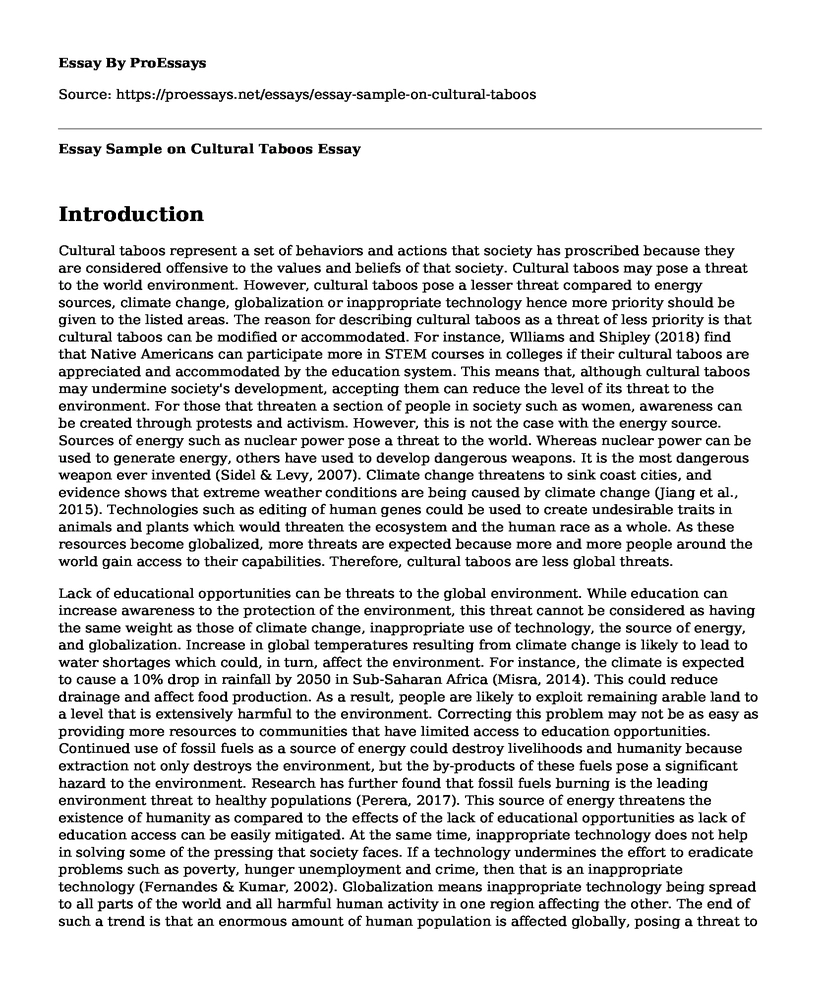Introduction
Cultural taboos represent a set of behaviors and actions that society has proscribed because they are considered offensive to the values and beliefs of that society. Cultural taboos may pose a threat to the world environment. However, cultural taboos pose a lesser threat compared to energy sources, climate change, globalization or inappropriate technology hence more priority should be given to the listed areas. The reason for describing cultural taboos as a threat of less priority is that cultural taboos can be modified or accommodated. For instance, Wlliams and Shipley (2018) find that Native Americans can participate more in STEM courses in colleges if their cultural taboos are appreciated and accommodated by the education system. This means that, although cultural taboos may undermine society's development, accepting them can reduce the level of its threat to the environment. For those that threaten a section of people in society such as women, awareness can be created through protests and activism. However, this is not the case with the energy source. Sources of energy such as nuclear power pose a threat to the world. Whereas nuclear power can be used to generate energy, others have used to develop dangerous weapons. It is the most dangerous weapon ever invented (Sidel & Levy, 2007). Climate change threatens to sink coast cities, and evidence shows that extreme weather conditions are being caused by climate change (Jiang et al., 2015). Technologies such as editing of human genes could be used to create undesirable traits in animals and plants which would threaten the ecosystem and the human race as a whole. As these resources become globalized, more threats are expected because more and more people around the world gain access to their capabilities. Therefore, cultural taboos are less global threats.
Lack of educational opportunities can be threats to the global environment. While education can increase awareness to the protection of the environment, this threat cannot be considered as having the same weight as those of climate change, inappropriate use of technology, the source of energy, and globalization. Increase in global temperatures resulting from climate change is likely to lead to water shortages which could, in turn, affect the environment. For instance, the climate is expected to cause a 10% drop in rainfall by 2050 in Sub-Saharan Africa (Misra, 2014). This could reduce drainage and affect food production. As a result, people are likely to exploit remaining arable land to a level that is extensively harmful to the environment. Correcting this problem may not be as easy as providing more resources to communities that have limited access to education opportunities. Continued use of fossil fuels as a source of energy could destroy livelihoods and humanity because extraction not only destroys the environment, but the by-products of these fuels pose a significant hazard to the environment. Research has further found that fossil fuels burning is the leading environment threat to healthy populations (Perera, 2017). This source of energy threatens the existence of humanity as compared to the effects of the lack of educational opportunities as lack of education access can be easily mitigated. At the same time, inappropriate technology does not help in solving some of the pressing that society faces. If a technology undermines the effort to eradicate problems such as poverty, hunger unemployment and crime, then that is an inappropriate technology (Fernandes & Kumar, 2002). Globalization means inappropriate technology being spread to all parts of the world and all harmful human activity in one region affecting the other. The end of such a trend is that an enormous amount of human population is affected globally, posing a threat to the survival of people on Earth.
References
Fernandes, A. C., & Kumar, K. B. (2002). Inappropriate technology. SSRN Electronic Journal. doi:10.2139/ssrn.301337
Jiang, C., Shaw, K. S., Upperman, C. R., Blythe, D., Mitchell, C., Murtugudde, R., ... Sapkota, A. (2015). Climate change, extreme events and increased risk of salmonellosis in Maryland, USA: Evidence for coastal vulnerability. Environment International, 83, 58-62. doi:10.1016/j.envint.2015.06.006
Misra, A. K. (2014). Climate change and challenges of water and food security. International Journal of Sustainable Built Environment, 3(1), 153-165. doi:10.1016/j.ijsbe.2014.04.006
Perera, F. (2017). Pollution from fossil-fuel combustion is the leading environmental threat to global pediatric health and equity: Solutions exist. International Journal of Environmental Research and Public Health, 15(1), 16. doi:10.3390/ijerph15010016
Sidel, V. W., & Levy, B. S. (2007). Proliferation of nuclear weapons: Opportunities for control and abolition. American Journal of Public Health, 97(9), 1589-1594. doi:10.2105/ajph.2006.100602
Williams, D. H., & Shipley, G. P. (2018). Cultural taboos as a factor in the participation rate of Native Americans in STEM. International Journal of STEM Education, 5(1), 1-8. doi:10.1186/s40594-018-0114-7
Cite this page
Essay Sample on Cultural Taboos. (2022, Nov 30). Retrieved from https://proessays.net/essays/essay-sample-on-cultural-taboos
If you are the original author of this essay and no longer wish to have it published on the ProEssays website, please click below to request its removal:
- Marriage Therapy Assessment Paper Example
- Essay Sample on PNC Bank
- Essay Example on the USA: A Rich Culture Marred by Racial Discrimination and Stereotyping
- Essay on Cultural Identity: Disenchantment & Structural Problems in Clinical Work
- Essay on the Quality of Friendship: A Primary Determinant of Social Development
- Essay Example on Karl Marx: Two Social Classes & Communist Manifesto
- Essay Example on Race, Ethnicity: 3 Sociological Perspectives







